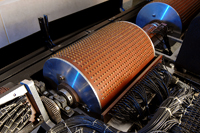AMES, Iowa - Iowa State University's full-scale, working replica of the Atanasoff-Berry Computer, a groundbreaking machine built on the Iowa State campus from 1939 to 1942, will be part of a major new exhibition at the Computer History Museum in Mountain View, Calif.
The replica of the Atanasoff-Berry Computer (ABC), the first electronic digital computer, will be part of the museum's multimillion-dollar, 25,000-square-foot exhibition opening in the fall of 2010. The exhibition will present more than 1,000 artifacts to tell the story of computing history and provide insights into how computing innovations have influenced everyday lives and will continue to make a significant impact on the global community.
The ABC replica, now on display in the lobby of Iowa State's Durham Center, will be moved to the museum by April 1, 2010. It will be on display for 10 years with the possibility of an additional five years. A display about the development and history of the ABC - including replicas of several vacuum tubes and one of the machine's rotating drums - will remain in the Durham Center.
 The
replica was completed and demonstrated in 1997 as a tribute to
the late inventors of the ABC, John Vincent Atanasoff, a former
Iowa State professor of physics and mathematics, and Clifford
Berry, a former physics graduate student and electrical engineering
undergraduate. It took a team of researchers, engineers,
faculty members, retired faculty and students from Iowa State
and the U.S. Department of Energy's Ames Laboratory four
years and $350,000 to build the replica ABC. The original was
dismantled during the late 1940s and almost entirely discarded.
The
replica was completed and demonstrated in 1997 as a tribute to
the late inventors of the ABC, John Vincent Atanasoff, a former
Iowa State professor of physics and mathematics, and Clifford
Berry, a former physics graduate student and electrical engineering
undergraduate. It took a team of researchers, engineers,
faculty members, retired faculty and students from Iowa State
and the U.S. Department of Energy's Ames Laboratory four
years and $350,000 to build the replica ABC. The original was
dismantled during the late 1940s and almost entirely discarded.
The ABC looks nothing like today's computers: It's the size of a big desk, weighs 750 pounds and features rotating drums for memory, glowing vacuum tubes and a read/write system that recorded numbers by scorching marks on cards.
But, the machine was also the first to use several innovations that are still a part of today's computers: a binary system of arithmetic, separate memory and computing functions, regenerative memory, parallel processing, electronic amplifiers as on-off switches, circuits for logical addition and subtraction, clocked control of electronic operations and a modular design.
"John Vincent Atanasoff and Clifford Berry were true pioneers in electronic digital computing," said Iowa State President Gregory Geoffroy. "As part of the new exhibition, the Computer History Museum can tell the story of their innovations to hundreds of thousands of museum visitors and millions of online visitors every year. And so we're pleased Iowa State's working replica of the ABC will be part of the museum's ambitious exhibit. The ABC deserves a prominent place in the history of computing."
The ABC's place in computer history has been the subject of debate and even a federal court case.
When World War II interrupted work on the ABC, Atanasoff and Berry moved on to other jobs and projects. J. Presper Eckert and John Mauchly, developers of the ENIAC machine at the University of Pennsylvania, were the first to patent an electronic digital computer. In 1973, however, U.S. District Judge Earl R. Larson overturned the ENIAC patents, writing, "Eckert and Mauchly did not themselves first invent the automatic electronic digital computer, but instead derived that subject matter from one Dr. John Vincent Atanasoff."
"Exhibiting the replica will greatly enhance the discussion of the ABC's significance," said Leonard J. Shustek, the chairman of the board for the Computer History Museum. "This is a controversial part of computing history, however, the museum is committed to telling the Atanasoff story in a way that fairly reflects its technical, historical and legal significance."
The museum's new exhibition is designed to celebrate the significant milestones of computing over 2,000 years. It will feature 1,000 artifacts, explanatory films, pioneering story videos, interactive exhibits, dioramas, audio tours and more.
"Who invented the computer is one of the most important and basic questions the exhibition discusses," Shustek said, "and one in which the ABC plays an important part of that discussion."
The Computer History Museum (CHM) in Mountain View, Calif., is a nonprofit organization with a four-decade history. The museum is dedicated to the preservation and celebration of computer history, and is home to the largest international collection of computing artifacts in the world, encompassing computer hardware, software, documentation, ephemera, photographs and moving images. CHM brings computer history to life through an acclaimed speaker series, dynamic Web site, onsite tours, as well as physical and online exhibits. Current exhibits include "Charles Babbage's Difference Engine No. 2;" "Mastering the Game: A History of Computer Chess;" "Innovation in the Valley" - a look at Silicon Valley startups; the unique "Visible Storage Gallery," featuring over 600 key objects from the collection; and the museum's newest exhibit, "The Silicon Engine" - the evolution of semiconductors. The museum's 25,000-square-foot, major, new exhibition will open in late 2010.
